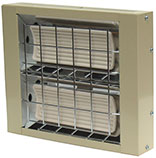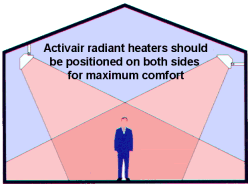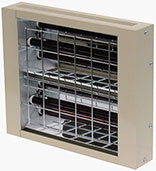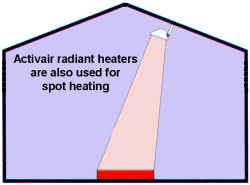
| ||||
W. Tombling Ltd.
Wembley House
Dozens Bank
West Pinchbeck
Spalding
Lincolnshire
PE11 3ND
U.K.


You are here:- home > heater index > radiant heating index > wall mounted radiant heaters > Installing infrared heaters
Selecting infrared heaters
Selecting the appropriate power for
infrared heater
installations depends on the size of the area to be heated and the building
type. To determine the total power (kW) of ceramic infrared heaters required
see, calculating radiant heat loads, or for a quick estimate use our on-line
radiant heater calculator.Once the power is known, the appropriate size and number of wall mounted ceramic infrared heaters can be selected. When selecting ceramic infrared heaters remember:
For an even spread of heat, several small infrared heaters are better than one large one.
For instance, if a workshop requires 9kW of ceramic infrared heaters. 6 - 1.5kW HC1500 ceramic infrared heaters will give more even spread of heat than 2 -4.5kW HC4500.
Positioning infrared heaters
Like the beam from a spotlight, the energy from infrared heaters can be directed exactly where required, however just like a spotlight careful positioning is important to avoid shadows (unheated area's), caused by beams, joists, etc.
The greatest benefit is felt when an area is heated from two sides and the beams overlap. Infrared radiant heaters should be mounted overhead on outside walls, or suspended from chains with the beam angled downwards at approximately 30 to 45 degrees.
To produce a uniform heating effect, infrared heaters should be positioned evenly throughout the area to be heated.
To achieve the best possible comfort levels, it is very important that infrared heaters are installed as near as possible to the recommended mounting heights.
If people are working near open doorways, windows, uninsulated walls etc. additional ceramic infrared heaters should be installed to provide extra zoned heating. See calculating radiant heat loads for further details.
Safety precautions for infrared heaters
Infrared heaters must not be installed where they will be knocked,
splashed or exposed to rain.To prevent overheating an air gap must be left between the top of the heater and the ceiling.
Infrared heaters should not be used in hazardous areas, in very dusty atmospheres, or where flammable vapours such as solvents are present.
Infrared heaters get very hot when operating, they should be installed out of reach, and precautions should be taken to prevent flammable materials coming into contact with the emitters.
Spot heating with infrared heaters
Infrared heaters produce infrared radiation, which is
particularly suited to drying and evaporating water, making them ideal for
drying paint, varnish, plaster, etc., and keeping doorways and paths ice free.For spot heating the radiant power (kW) given by our online calculator should be multiplied by a factor of 2 or 3.
When using wall mounted infrared heaters for spot heating, the heater can be placed as close as 1m from the surface being heated. The optimum distance should be found by experimentation, and will depend on the surface temperature required, its spectral absorption, and the size of radiant heater used.
You are here:- home > heater index > radiant heating index > wall mounted radiant heaters > Installing ceramic infrared heaters
If you found this page useful, please take a moment
to tell a friend or colleague about it.
Copyright © 2004/6, W. Tombling Ltd.